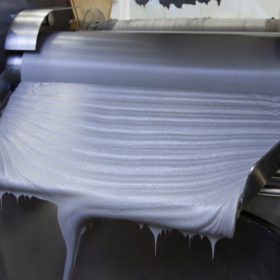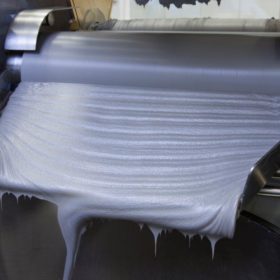New metallization paste range from Heraeus

The SOL 7 series comprises five products for Perc, Topcon and heterojunction devices.
German silver metallization paste maker Heraeus has launched a range of products aimed at the manufacture of high-efficiency solar cells.
The SOL 7 Series comprises five silver pastes intended for PV technologies including mono and multicrystalline Perc cells, Topcon and heterojunction devices.
The SOL9671B product is intended for the production of ultra-lightly-doped emitter (ULDE) and passivated-emitter rear-contact (Perc) cells. The manufacturer said the paste is based on glass chemistry upgraded from the previous generation of products to offer superior metallization contact and an organic vehicle system for ultra-fine-line (UFL) printing. Heraeus says the paste has a wide firing window toward a lower temperature side which is particularly suitable for Perc devices.
The SOL6700 dual-printing busbar paste is made with a chemistry which can offer a controlled reaction between paste and dielectric layer, raising protection of the latter during metallization, according to Heraeus. The manufacturer said the increased protection offered by the product reduces electron recombination while raising open-circuit voltage. The SOL6700, says Heraeus, is compatible with cell technologies including Perc, double passivation and n-type devices. “This paste provides excellent adhesion and a wide soldering window,” the manufacturer said.
Resistivity
The third paste – SOL9390A – is said to be compatible with double and dual printing and to provide better contact resistivity for p+ emitter in n-type cells. Compared to Heraeus’ previous pastes for n-type technology, the product is said to offer improved printability and line uniformity.
The SOL7300 paste is offered for the production of Perc cells with Topcon technology. “Excellent contact resistivity is achieved even when fired at lower temperatures, and supports [an] ultra-thin poly layer,” said Heraeus. The manufacturer claims the paste allows lower firing temperatures, to reduce the impact of metal-induced recombination and maintain high cell open-circuit voltage while providing excellent contact resistance.
The SOL590 is a product designed for the manufacture of heterojunction (HJT) cells. It shows strong contact resistivity and unique low curing temperature, according to its manufacturer. “The Heraeus SOL590 has been developed based on our recent improvement in low-curing-temperature paste chemistry, combined with the latest breakthrough in silver powder development and organic design, [it offers] faster cure times, higher efficiencies and greater adhesion than commercially available materials,” the company said.
Heraeus Photovoltaics president Wen Zhou said: “Cell manufacturers continue to search for new ways to deliver greater Perc efficiencies and improve module reliability. The newest additions to the SOL 7 Series paste portfolio are designed to help them achieve that.”


